Transforming lives: Pashupati's dedication and Laxmi's recovery from malnutrition
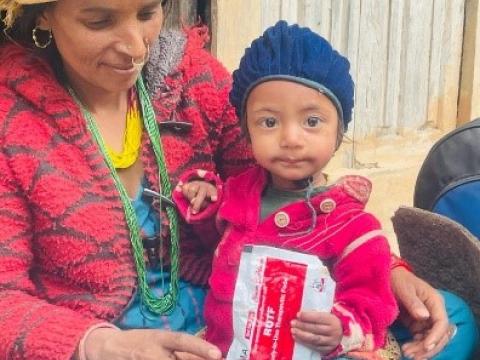
Pashupati and her 13-month-old daughter Laxmi, along with the other 7 members of the family, were getting ready for bed on the night of November 3, 2023. Pashupati was trying to put Laxmi to sleep while the rest of her children were already asleep. It was just like any other night in Jajarkot, except at 11:47 PM, a powerful earthquake measuring 6.4 magnitude shook Jajarkot and West Rukum, which resulted in many houses being destroyed and lives lost. The disaster did not spare Pashupati’s family as well. Immediately after the earthquake, Pashupati woke her children but did not step out of the house due to fear. Her house, made of mud and stones, was cracked, but fortunately, it did not collapse. Unlike in the neighbourhood, there were no casualties in her family. Her family has been taking shelter in a tarpaulin since the disaster.
Pashupati’s family belongs to a Dalit community, which is among the most vulnerable. She has seven children (6 daughters and a son). Her husband, Kali Bahadur, is the only breadwinner in the family and works as a welder of agricultural tool kits such as sickles and axes. They have a kitchen garden with limited production that lasts no more than ten months per year. Due to inadequate resources, sometimes they don’t have enough food to feed all their family members. It was evident that they did not have awareness about family planning and nutritional behaviours.
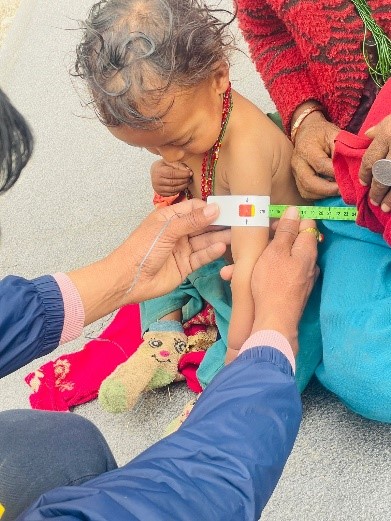
Laxmi weighed only 2200 grams when she was born. She did not receive proper breastfeeding during her early years because her mother was unable to produce enough milk. Right after two weeks of birth, Laxmi and Pashupati were ill due to the cold weather, which lasted for three months. As a result, Laxmi lost her appetite and lost more weight due to a lack of nutrition. Meeting the daily nutritional requirement of a 13-month-old child was already challenging with so many mouths to feed and minimal income. The earthquake further added to the vulnerability, as the family had to bear the trauma of life security and food security at the same time. Children under 5 years are vulnerable to Acute Malnutrition, either Moderate Acute Malnutrition (MAM) or Severe Acute Malnutrition (SAM). Following the earthquake, Laxmi's daily food requirement was not met, resulting in her suffering from SAM.
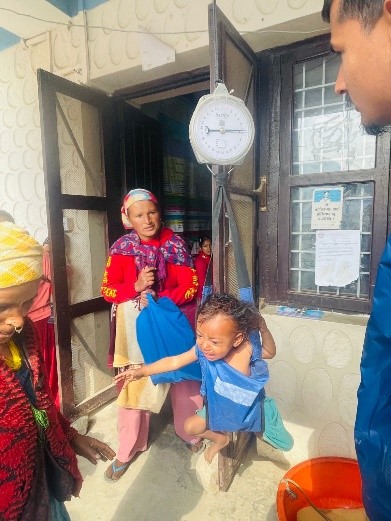
"A FCHV came for MUAC screening of my child, and she detected that my daughter Laxmi was in red. She told me to take her to the nearest health facility as soon as possible. When I took her to the health facility, she was immediately admitted and received medication. I am very thankful to the FCHVs, as I didn’t have knowledge about what had happened to my daughter. She helped my daughter in time, and I understood the cause of her illness." - Pashupati (Mother of Laxmi)
One month after the earthquake, Padam Kala, a Female Community Health Volunteer (FCHV) visited Laxmi for Mid Upper Arm Circumference (MUAC) screening. The screening was organized after a one-day training for FCHVs conducted by Nepal Technical Assistance Group (NTAG) through the Start Fund Nepal (SFN) - N19 Project led by World Vision International Nepal. Upon MUAC screening, Laxmi was found to be suffering from severe Acute Malnutrition (SAM). The FCHV immediately recommended Pashupati take her daughter Laxmi to the closest Outpatient Therapeutic Centre – OTC at the Primary Hospital for SAM treatment. After rigorous follow up with Laxmi’s family, by FCHVs and NTAG, she was taken to the OTC centre. On reaching Dalli Hospital OTC Centre, Laxmi was admitted for treatment and recommended to have Ready to Use Therapeutic Food (RUTF) and WASH behaviour i.e., hand washing at critical stages and feed treated water. Similarly, she was asked to have frequent follow-up visits on a weekly basis.
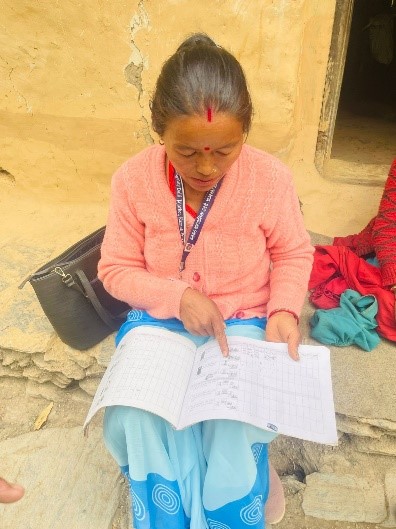
"I received a one-day training on screening SAM and MAM from NTAG, and I went for screening in my community after the training. I found that 13-month-old Laxmi was in red, so I suggested her mother take her to the nearest OTC as soon as possible because her daughter was suffering from Severe Acute Malnutrition (SAM). Because of the training I received from NTAG, I was able to help Laxmi and save her on time." - Padam Kala Thapa, FCHV, Jajarkot
After returning to their house, Pashupati followed the recommendation provided by the OTC Focal Person and started to breastfeed Laxmi along with RUTF and treated water as her daily diet. Pashupati shares that Laxmi likes to eat RUTF and her health has improved. Laxmi's appetite and weight improved after treatment. She gained 600 grams within a month and continues to gradually improve. Pashupati was also suggested to pay frequent visits to the Health Facility (HF) to track her daughter’s health and nutrition status, for which she chose a nearby health facility, a Basic Health Service Centre. She plans to visit the health facility Hospital OTC each month, as the OTC is 3 to 4 hours of walk from her home.
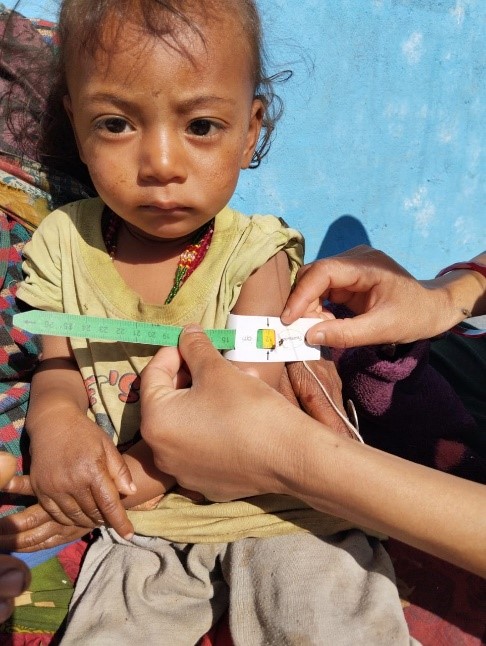
The MUAC screening conducted through the project identified a total of 453 children who were suffering from acute malnutrition (SAM: 43 and MAM: 410). 43 children suffering from SAM were referred to health service facilities for further treatment, and 410 children suffering from MAM were supported with a nutrition-dense diet for MAM management.